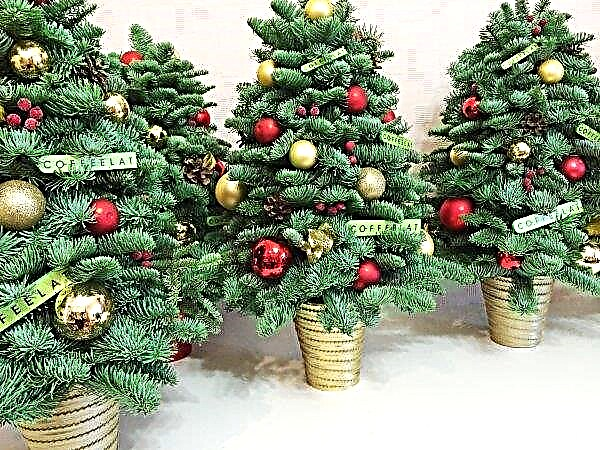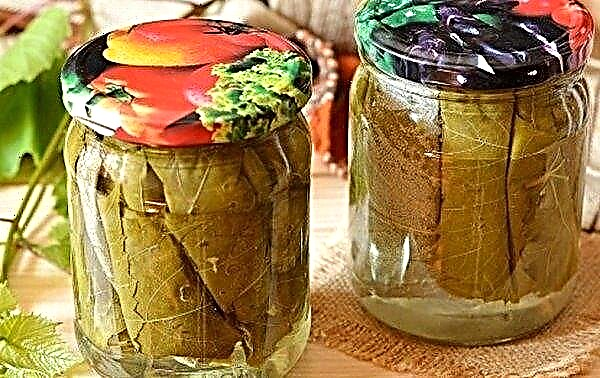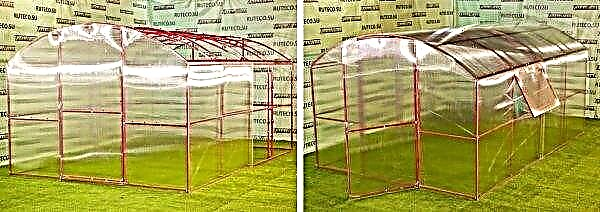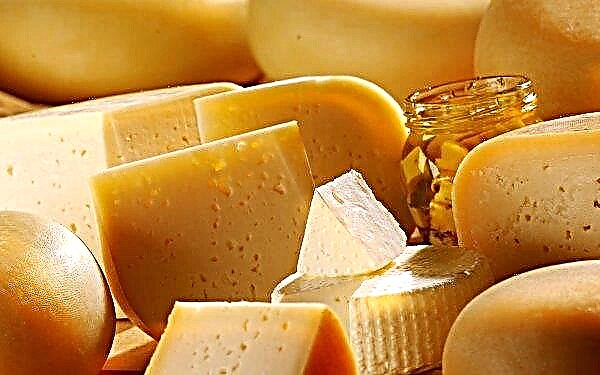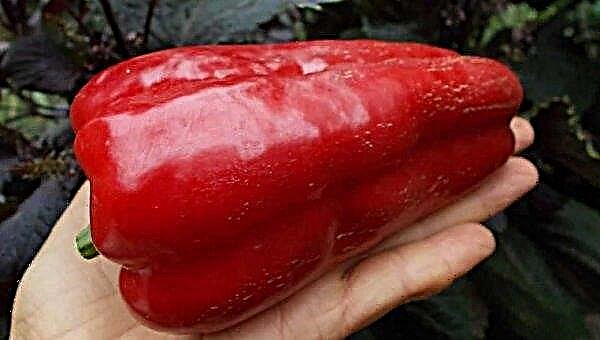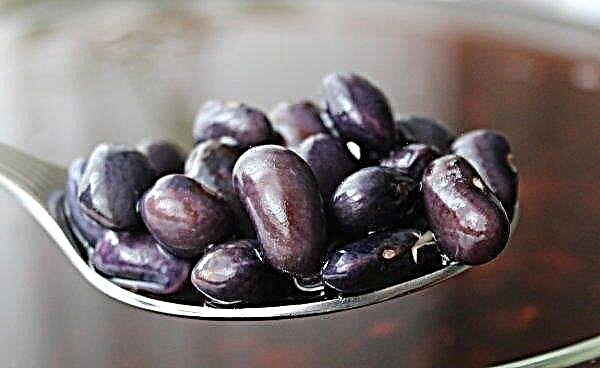Florists often confuse ribbed euphorbia with some types of palm trees. Judging by the appearance, there is a similarity, but, unlike exotic plants, euphorbia has a number of advantages, due to which the flower is widespread. What are its features, and how to grow euphorbia a real decoration for the house - read on.
Botanical description of the plant
The flower belongs to the euphorbia family and was first discovered in vivo in Madagascar.
Remarkable due to appearance:
- the color of the stem ranges from dark brown (bottom) to dark green (younger areas);
- has the shape of a pentagon, dotted with gray scars, which are smoothed out as the flower grows;
- in height can reach 1.8–1.9 m;
- there are no branches on the plant;
- at the top, oval, slightly elongated leaves with red petioles are collected in a bunch;
- the upper part of the leaf plate is glossy, bright green in color, the lower part is lighter, almost light green, which allows the plant to absorb more light.
Important! Milkweed has poisonous milky juice, which can cause an allergic skin reaction.
Due to the unusual stem, the euphorbia looks like a representative of succulents, but the armful of leaves on its top resembles a palm tree.
In summer, inflorescences with white-pink petals appear on the top of the plant on red-yellow peduncles. They can bloom for several months, and then in their place appear box fruits. When seeds ripen in them, the fruits burst, scattering the seed around itself for 3 m.

| Root system | Developed, fragile |
| Stem | Pentagon, dark green with scars |
| Leaf shape | Elongated oval |
| Leaf color | Light green |
| Flower shape | Cup-shaped |
| Flower color | White, pink |
| Fruit shape | Boxes |
| Fruit color | Dark brown |
Medicinal properties and harm
The name Euphorbia was obtained from the ancient Greek physician Euphorbos, who was the first to use the plant’s milky juice as a medicine.
- The plant is still used in the treatment of the following problems:
- leaf infusion is used in the fight against age spots, dry corns, warts, fungus;
- decoction from the roots treats diseases of the stomach, liver;
- in homeopathy they are used as an anesthetic and laxative;
- the milky juice of the flower is part of the healing, anti-aging drugs;
- in modern pharmacology, it is a component of drugs for cystitis and hemorrhoids.
Did you know? Feng Shui experts recommend keeping euphorbia in the house to attract positive energy and harmony.
- As with any medicinal plant, with milkweed, care must be taken:
- you can not use products that contain leaves or juice of this plant to pregnant or lactating women;
- contact with skin, mucous membranes provokes allergic reactions;
- eating causes burns to the oral cavity, gastrointestinal tract, as well as nausea and vomiting;
- excess doses of milk-based drug can lead to blindness and even death.
House growing conditions
Unpretentiousness to the conditions necessary for development distinguishes it from succulents and palm trees, which are so similar to ribbed euphorbia.

Lighting
Comfortable for the flower will be placement in places where diffused lighting. Excess light provokes burns on its leaves, and the trunk is covered with a dark protective carapace. A long stay in a place without enough light leads to leaf falling. To avoid this, add artificial lighting.
Important! If you are looking for a plant to be placed deep in the room, then an euphorbia is not the best option: after 2–3 weeks, he will begin to lose leaves due to a lack of light.
Ventilation
A flower loves fresh air, so in the warm season it is useful to take it to an open balcony or garden. In room conditions, they provide periodic ventilation, avoiding drafts that are harmful to the plant.
Temperature mode
As a native of the tropics, milkweed needs warmth. In summer, the optimal range for it will be +20 ... + 25 ° С, and in winter it is necessary to ensure the temperature of the content is not lower than + 16 ° С. If the room is cold, plant growth will slow down. Excessive heat leaves the leaves fade and fall.
Air humidity
All species of this family tolerate dry air well, but spraying is useful to them. During the procedure, dust is removed from the plant and prophylaxis against pests that love overdried leaves occurs.
How to care at home?
Unpretentious milkweed manifests itself in the care. You do not have to spend a lot of time on this flower, but some features require attention.
Did you know? According to popular beliefs, if you do not provide milk for proper care, all its positive effects on family well-being turn into negative.
Watering
The beautiful appearance of the plant depends on the proper watering. To moisten the milkweed soil, soft, well-maintained water at room temperature is used.

In summer, the flower is watered 1-2 times a week, and in particularly hot periods this can be done every day, accompanying the spraying procedure. In autumn, the amount of watering is reduced to 1 time per week, in cold weather it is enough to moisten the soil 1-2 times a month.
Milk milk is irrigated under the root so that the water does not stagnate on the leaves, provoking various diseases.
Top dressing
In autumn and winter, when the milkweed has a dormant period, fertilizers are not applied. But during the flowering or active growth in spring and summer, you can not do without dressing. It is advisable to feed ribbed euphorbia every week, using complexes for cacti, succulents. It is allowed to use universal fertilizers for indoor plants, but they will have to be diluted twice as weak as indicated in the instructions.
Important! Potassium supplements are especially useful for milkweed during the flowering period.
Crown pruning
Milkweed will not hurt pruning as soon as the flowers fade. They must be removed along with dry cuttings, yellowed leaves, so as not to spoil the beautiful crown of the plant.
Transfer
A flower is transplanted infrequently, every 2-3 years, but it is necessary to do this in spring.
There are no special requirements for tanks, you just need to take a pot larger than the previous one and with a hole for water drainage. Put expanded clay or medium-sized pebbles with charcoal on the bottom of the flowerpot for high-quality drainage and prevention of root rot.
Since euphorbia in natural conditions grows in sandy soils, ready-made substrates for succulents or cacti are suitable for a home plant. You can prepare the land for the plant yourself.
To do this, take in equal parts:
- sheet soil;
- peat;
- sand.
Breeding
In nature, euphorbia is spread by seeds, which scatter in all directions from box fruits. Florists, on the other hand, prefer to propagate this flower with cuttings and dividing in order to get an adult plant as soon as possible.
Cuttings
To get the cuttings, the top of the plant is cut, because it does not have separate branches. After the cuttings are separated, the mother flower loses its decorativeness until a new crown is grown, so not many flower growers practice this method. But it is actively used in cases of root decay, when there is a need to save a healthy crown, replanting it with a separate plant. The best time for grafting is July.
The breeding process is simple:
- Carefully separate the apex from the stem.
- Let the milky juice drain from the future cuttings.
- The cut is treated with charcoal.
- For 2-3 days, the stalk is left in the shade.
- After the specified time, the seedling is lowered into a wet mixture of peat and sand to form the root system.
- When new roots braid over a lump of substrate, this is a signal that the stalk is ready to plant a pot in the soil.
Division
By dividing the bush, the flower is transplanted in March-April or September. But they do it rarely.
Important! The method of division causes stress in the plant, therefore, after such a transplant, it will take him a year or two to restore active growth and begin to bloom.
The procedure consists of several steps:
- Remove the plant from the pot.
- Carefully inspect its roots for rot damage. If there are such areas, then carefully trim them and sprinkle the cut places with charcoal, otherwise the roots will continue to deteriorate.
- After that, divide the root tuber. Try to do this without scissors, manually separating the thin processes.
- Sometimes you can’t do without cutting the roots, so carefully treat the cutting surfaces of the knife or scissors with an antiseptic, and only then perform the “operation”.
- Wash the places of cuts with warm water, it will stop the milky juice, and then treat the resulting wounds with charcoal.
- The resulting part of the root coma can be immediately planted in a new pot.

Growing difficulties
Although the euphorbia is ribbed and unpretentious, sometimes the following problems arise when growing it:
- The plant stretches unnaturally quickly up, and the leaves on it grow smaller than usual - there is not enough light and you need to move the pot with the plant to another place.
- The flower lowers the leaves, and then drops them - lack of moisture, watering must be increased, otherwise there is a risk of ruining the plant.
- The leaves turn yellow first, and then fall off - excess moisture or sudden temperature changes in the room. Try to dry the euphorbia for several days or rearrange it to another place.
- Root rot - excess moisture. If she hit the plant, then there is no other way but to cut the green top and transplant it like a stalk.
- Powdery mildew - Appears with prolonged non-compliance with the rules of care (lack of fertilizing, lack of space, lack of light, stagnation of water). You can recognize the disease by white plaque on the leaves, which over time become brownish with fungal spores. Milk whey (in an aqueous solution of 1:10), which is treated with leaves, or chemical preparations (Fundazol, Topaz, Amistar) will help cure euphorbia.
- Aphids or spider mites can live on the flower. They love weakened plants, so make sure that milk contains enough nutrients. The appearance of aphids is evidenced by small white insects and holes on the leaves from their life activity. A tick is easily recognizable by its thin, sticky web. Washings with soapy water and spraying with citrus infusion will help get rid of pests (pour 100 g of orange or lemon peels with water and leave for 3 days in a warm room). If there are too many insects, then use insecticides (Actellik, Confidor, Neoron).
Ribbed euphorbia can often be found in most indoor gardens. It is popular due to its exotic appearance and unpretentiousness in care. In addition to decorative properties, it also has healing properties. With proper care, the plant will decorate any room for a long time.Did you know? Popular beliefs say that euphorbia (like a flower with thorns) can not be put in the bedroom so that there are no conflicts between spouses.

